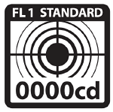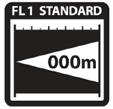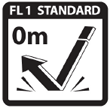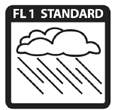ANSI Standards
In 2009 , the National Electrical Manufacturers Association (NEMA) and the American National Standards Institute (ANSI) created the first worldwide standards of defining, measuring, and labeling basic flashlight performance. These standards, called ANSI/NEMA FL1, will allow consumers to choose the best flashlight for their needs using simple icons that rate the following features of your lighting tools: Peak Beam Intensity, Beam Distance, Impact Resistance, Run Time, Light Output, Water Resistance, and Water Proof. Check the chart below for icons and explanations of each standard.
| Peak Beam Intensity Reported in candela units, the peak beam intensity represents the brightest part of the flashlight's beam. The light output is measured by candela meters and light sensors on targets placed at a distance of two, ten, and thirty meters. This icon will allow you to compare the maximum brightness of flashlights. |
| Light Output While the peak beam intensity standard measures only the brightest part of the light's beam, the Light Output measurement accounts for the total emission of light energy by the sample device. This standard is measured in lumens. |
| Beam Distance The beam distance measures the point at which the flashlight's beam is 0.25 lux (equal to the light emitted by a full moon on a clear night). This distance is measured in meters. |
| Impact Resistance The impact resistance is measured by dropping samples onto a concrete surface from a minimum of one meter. To be considered impact resistant at a certain height, the sample cannot crack or break upon impact and must retain full functionality after the test. |
| Run Time The run time icon represents the number of hours and/or minutes it takes for the flashlight's light output to drop by 10% under continuous operation. This standard can be measured in hours, minutes, or both hours and minutes. |
| Water Resistance This icon indicates a lighting device's tolerance for water exposure. To be considered water resistant under ANSI standards, the device cannot show any harmful effects within 30 minutes of being splashed with water from any direction. |
| Water Proof or Submersible A device considered as water proof or submersible under ANSI standards must retain functionality for at least 30 minutes after temporary placement underwater at a minimum depth of one meter. If functionality is not retained for 30 minutes, or if unprotected electrical components are exposed to water, the device will NOT be considered water proof or submersible. |








